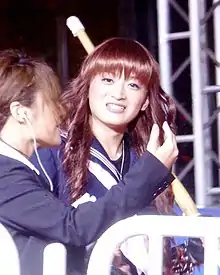
| Cross-dressing |
|---|
Otokonoko (男の娘, "male daughter" or "male girl", also pronounced as otoko no musume) is a Japanese term for men who have a culturally feminine gender expression.[1][2] This includes amongst others males with feminine appearances, or those cross-dressing. "Otokonoko" is a play on the word 男の子 ("boy", from the characters for 'male' and 'child'), which is also pronounced otokonoko; in the slang term, the kanji for "child" (子) is substituted with "daughter"/"girl" (娘).
The term originated in Japanese manga[2] and Internet culture in the 2000s, but the concept reflects a broad range of earlier traditions and examples of male cross-dressing in Japan, such as onnagata in kabuki theater. Its popularity increased around 2009, with the rise of dedicated maid cafés, fashion stores, cosmetic products, and a range of popular media in the otaku culture.[3] It is often combined with the cosplay of female fictional characters by men (crossplay).[1]
By extension, otokonoko is also a genre of media and fiction about feminine-looking or feminine-dressing men, and often contains erotic or romantic elements. It is mainly aimed at male audience but also appears in a lot of shōjo manga. Otokonoko characters have also begun to appear in mainstream Japanese popular entertainment such as manga, anime, and video games.[1]
See also
References
- 1 2 3 Ashcraft, Brian (26 May 2011). "What Is Japan's Fetish This Week? Male Daughters". Kotaku. Retrieved 5 January 2014.
- 1 2 "Otokonoko : des garçons trop mignonnes". Vice. 8 August 2013. Archived from the original on Mar 22, 2020. Retrieved 5 January 2014.
- ↑ 森友, ひい子 (2 June 2014). "「男の娘」「女装子」と呼ばれる人々 "中性化受け入れ"円満な夫婦の鍵 〈週刊朝日〉". AERA dot. (アエラドット) (in Japanese). Retrieved 14 March 2018.